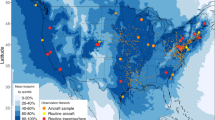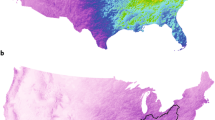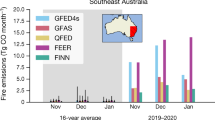Abstract
The relation between sources of sulphur dioxide (SO2) and precipitation sulphate (SO4) concentrations at distant receptors is the subject of intensive empirical and theoretical investigation1,2. This relation provides a probe of atmospheric chemistry, physics and meteorology, and insight into the effectiveness of potential acid-deposition reduction strategies. Large variations in SO2 emissions from copper smelters in the southwestern United States, the major regional sulphur source, between 1980 and 1984 provide a unique opportunity to study the source–receptor relation, as during this interval the National Atmospheric Deposition Program (NADP) monitored wet-precipitation sulphate concentrations on a weekly basis at Rocky Mountain locations. Here we extend our earlier analysis of annual-average data2 by examining monthly sulphate concentration and emission data for 1980–84. We show that monthly data are consistent with a linear relation between emissions and concentration, possessing the expected properties of a source–receptor relation. We then predict concentration changes resulting from the addition of a new smelter at Nacozari, Mexico, expected to be the second-largest source of SO2 in North America.
This is a preview of subscription content, access via your institution
Access options
Subscribe to this journal
Receive 51 print issues and online access
$199.00 per year
only $3.90 per issue
Buy this article
- Purchase on Springer Link
- Instant access to full article PDF
Prices may be subject to local taxes which are calculated during checkout
Similar content being viewed by others
References
Work Group 2 US–Canada Memorandum of Intent on Transboundary Air Pollution (Environmental Protection Agency, Washington, 1982).
Oppenheimer, M., Epstein, C. B. & Yuhnke, R. E. Science 229, 859–862 (1985).
National Atmospheric Deposition Program Data Reports, Precipitation Chemistry (Natural Resource Ecology Laboratory, Colorado State University, 1980–84).
Stenslund, G. J. et al. NADP Quality Insurance Report, Central Analytic Laboratory (Illinois State Water Survey, Urbana, 1979).
Junge, C. E. Air Chemistry and Radioactivity, Ch. 4 (Academic, New York, 1963).
Cleveland, W. S., Devlin, S. J. & Terpenning, I. J. The SABL Seasonal and Calendar Adjustment Package (Bell Laboratories, Murray Hill, 1982).
Yuhnke, R. & Oppenheimer, M. Safeguarding Acid-Sensitive Waters in the Intermountain West (Environmental Defense Fund, Inc., New York, 1984).
Work Group 3B US-Canada Memorandum of Intent on Transboundary Air Pollution (Environmental Protection Agency, Washington, 1982).
Pechan, E. H. & Wilson, J. H. Jr, J. Air Pollut. Control Ass. 34, 1075–1078 (1984).
Latimer, D. H. Modeling Regional Haze in the Southwest: A Preliminary Assessment of Source Contributions (Systems Applications, Inc., San Rafael, 1985).
Oppenheimer, M. Atmos. Envir. 19, 1439–1443 (1985).
Knudson, D. A. An Inventory of Monthly Sulfur Dioxide Emissions for the Years 1975–1983 (Argonne National Laboratory Publ. No. ANL/EES-TM-277, 1985).
Dupuis, L. R. & Lipfert, F. W. preprint, Brookhaven National Laboratory (1985).
Author information
Authors and Affiliations
Rights and permissions
About this article
Cite this article
Epstein, C., Oppenheimer, M. Empirical relation between sulphur dioxide emissions and acid deposition derived from monthly data. Nature 323, 245–247 (1986). https://doi.org/10.1038/323245a0
Received:
Accepted:
Issue Date:
DOI: https://doi.org/10.1038/323245a0
Comments
By submitting a comment you agree to abide by our Terms and Community Guidelines. If you find something abusive or that does not comply with our terms or guidelines please flag it as inappropriate.



